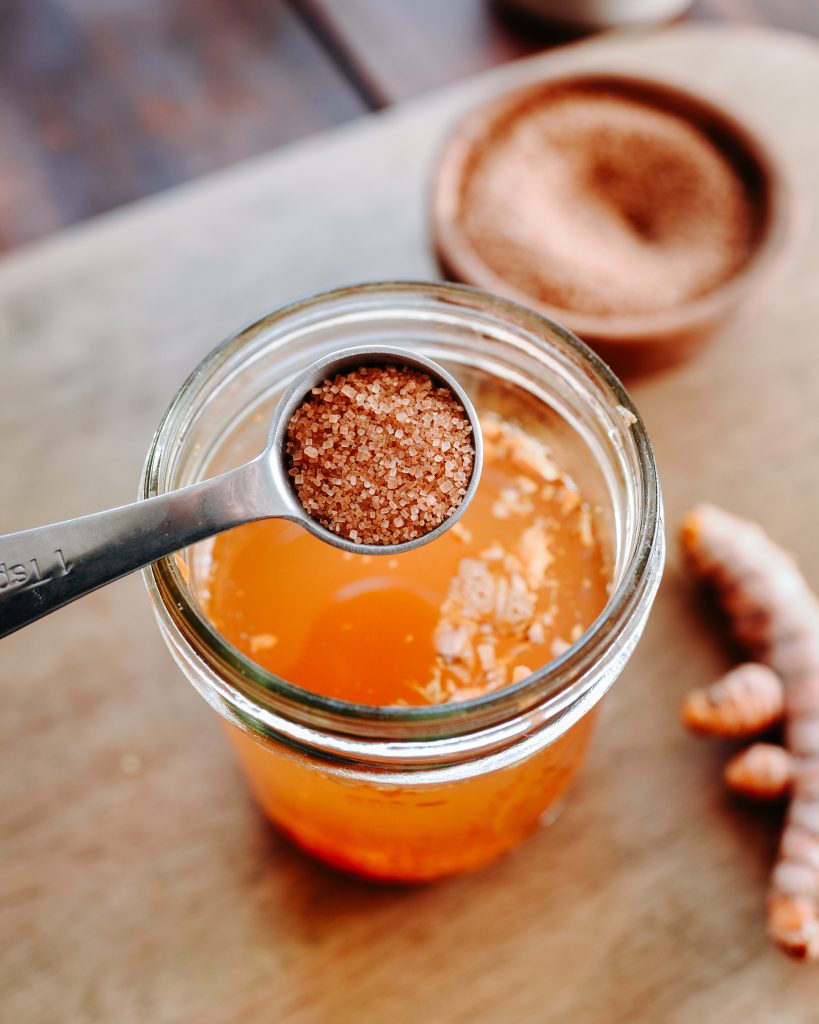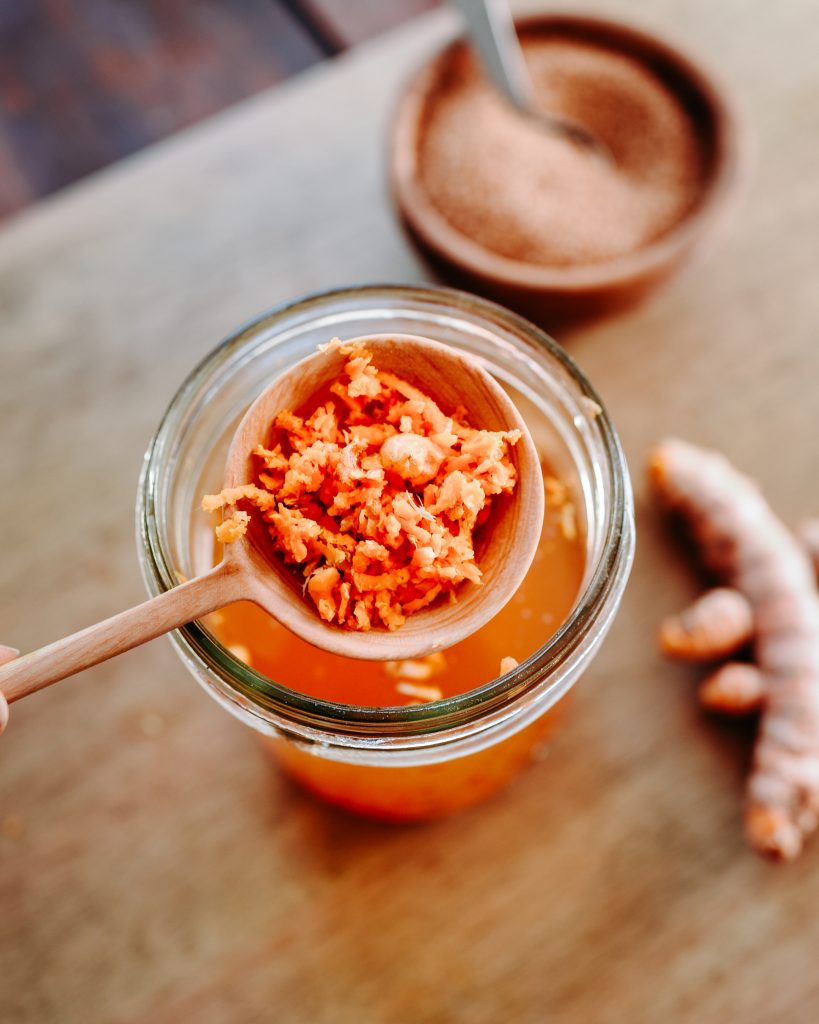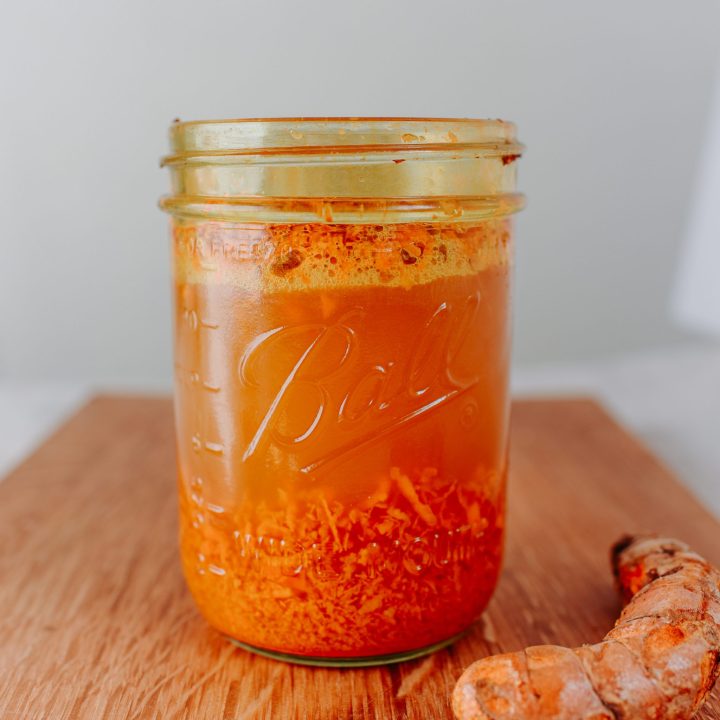Making a turmeric bug is simple and requires minimal hands-on time. All you need is turmeric, sugar, water, and a little patience and time. A turmeric bug can be used to make a delicous fermented turmeric soda.

What Is A Turmeric Bug?
A turmeric bug is simply a starter composed of turmeric and the yeast culture that naturally lives on turmeric (the bugs). It’s one of the easiest ways to get a yest starter going.
You can substute ginger for turmeric for a more neutral starter and you can find tons of recipes for how to make a “ginger bug” online or in books.
The great thing about a turmeric bug is that is that it works like a charm, is easy to get started, and can be kept dormant in the fridge for whenever you want to make fermented turmeric soda!
I’ll share my recipe for making a turmeric bug belowe, but feel free to do your research and choose a method that works for you.

Tips For Making A Sucessful Turmeric Bug
Organic turmeric — use fresh organic turmeric to make a turmeric bug with. Nonorganic turmeric may be irradiated, a process which kills all bacteria living on the surface of the turmeric. This is the most common reason for an unsuccessful turmeric bug.
Ferment at room temperature — and avoid placing the bug in direct sunlight. The heat from the sun can warm up the turmeric bug too much and kill the yeast you are trying to cultivate.
Feed every 3-4 days — Keep feeding the turmeric bug while you are getting it started until you have a nice bubbly fermentation going. To keep a turmeric bug alive, it needs to be fed continuously with 1 tablespoon (15 g) fresh turmeric, 1 tablespoon (12 g) sugar, and 1 tablespoon (15 ml) water. If you don’t make frequent fermented beverages, you can store the turmeric bug in the fridge and feed it once a week instead.
Non-chlorinated water — chlorine in water can prevent a successful fermenation from happening. If you have chlorinated water, a simple trick is fill a container and let it sit overnight. This allows the chlorine to evaporate.

How To Make A Turmeric Bug
Ingredients:
- 3–4 tablespoons (40–50 g) grated or sliced organic turmeric
- 1/4–1/2 cups (60-100 ml) organic cane sugar
- 2 cups (500 ml) water (non-chlorinated)
Directions:
- Mix all your ingredients in a clean jar, such as a quart jar. Screw the lid on top, but not too tightly. Once the fermentation gets started, there will be fermentation gases that need to escape. Several times a day, screw the lid on tight and shake the jar, then loosen the lid again.
- Set the turmeric bug on the counter out of direct sunlight. Place the jar in a bowl or tray to catch any spills.
- Twice a week, add 1 tablespoon (15 g) grated/sliced turmeric, 1 tablespoon (12 g) sugar, and 1 tablespoon (15 g) water. Keep the turmeric bug on the counter during this process (or room temperature). Usually, it takes about 7 days to get a nice bubbly turmeric bug going. It happens faster in warmer temperatures, and much slower in winter or cold climates.
- If the fermentation doesn’t become bubbly, simply discard it and start over. This could be because the turmeric was not organic.
- Once you have an active, bubbly turmeric bug that fizzes when you open it and sprinkle some sugar in, it’s ready to use to ferment turmeric soda.
- Keep the turmeric bug alive by continuously feeding it every 3 to 4 days. Or place it in the refrigerator and feed it just once week or so with 1 tablespoon of turmeric, 1 tablespoon sugar, and 1 tablespoon water.
Note: I often forget to feed my ginger and turmeric bugs for weeks in the fridge and have still been able to revive it easily. It’s quite resilient!

Turmeric Bug
A turmeric bug is a yeast culture made with turmeric, sugar, and water. It can be used to make fermented turmeric soda.
Ingredients
- 3-4 tablespoons (40--50 g) grated or sliced organic turmeric
- 1/4-1/2 cups (60-100 ml) organic white or cane sugar
- 2 cups (500 ml) water (non-chlorinated)
Instructions
Mix all your ingredients in a clean jar, such as a quart jar. Screw the lid on top, but not too tightly. Once the fermentation gets started, there will be fermentation gases that need to escape. Several times a day, screw the lid on tight and shake the jar, then loosen the lid again.
Set the turmeric bug on the counter out of direct sunlight. Place the jar in a bowl or tray to catch any spills.
Twice a week, add 1 tablespoon (15 g) grated/sliced turmeric, 1 tablespoon (12 g) sugar, and 1 tablespoon (15 g) water. Usually, it takes about 7 days to get a nice bubbly turmeric bug going. It happens faster in warmer temperatures, and much slower in winter or cold climates.
If the fermentation doesn't become bubbly, simply discard it and start over. This could be because the turmeric was not organic.
Once you have an active, bubbly turmeric bug that fizzes when you open it and sprinkle some sugar in, it's ready to use to ferment turmeric soda.
Keep the turmeric bug alive by continuously feeding it every 3 to 4 days. Or place it in the refrigerator and feed it just once week or so with 1 tablespoon of turmeric, 1 tablespoon sugar, and 1 tablespoon water.
Notes
You can put your turmeric bug to "sleep" by keeping it in the fridge. It only needs to be fed the usual amount once every week or so. I often forget to feed mine for weeks at a time, and can always revive it. It's very resilient.
2 Comments
Fermented Turmeric Soda - Everyday Homestead Fermented Turmeric Soda
January 18, 2023 at 5:00 pm[…] See my post for detailed instructions on how to make a turmeric bug here. […]
Fermented Strawberry Lemonade - Everyday Homestead
January 24, 2023 at 3:56 am[…] Ginger Bug — You will also need a ginger bug to make fermented strawberry lemonade. A ginger bug is a wild yeast starter made with ginger, water, and sugar and takes up to a week before it’s ready. Learn how to make a ginger bug here. […]